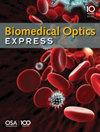基于光学相干断层扫描的三维粒子条纹测速仪,用于评估体内小鼠输卵管中植入前胚胎的移动情况
IF 2.9
2区 医学
Q2 BIOCHEMICAL RESEARCH METHODS
引用次数: 0
摘要
哺乳动物的输卵管(或输卵管)是一个管状器官,承载着导致怀孕的生殖过程。最近,利用光学相干断层扫描(OCT)对小鼠输卵管进行动态三维成像已成为一种很有前途的方法,可用于研究对阐明输卵管在哺乳动物生殖和生殖疾病中的作用至关重要的隐藏过程。特别是,利用体内视窗,活体 OCT 成像是研究输卵管如何将着床前胚胎运送到子宫进行妊娠的有力解决方案,这是一个长期存在的问题,对于揭示输卵管异位妊娠的功能性原因至关重要。然而,由于 OCT 的容积成像率普遍有限,同时跟踪胚胎运动和获取输卵管活动的三维大视场图像一直是个难题。缺乏基于 OCT 的大型稀疏颗粒三维测速方法成为分析胚胎运输机理过程的技术障碍。在此,我们报告了一种新的颗粒条纹测速方法来解决这一障碍。该方法依赖于在采集单个 OCT 容积时形成的运动粒子的三维条纹,在每个 B 扫描位置采集双 B 扫描,以解决评估粒子运动时的模糊性。我们用流体模型中的黄金标准--直接体积颗粒跟踪法验证了这种方法,并展示了它在胚胎测速和输卵管成像中的体内应用。这项工作为定量了解输卵管在体内的传输功能奠定了基础,该方法填补了基于 OCT 测速仪的空白,为三维流动成像的新应用提供了可能。本文章由计算机程序翻译,如有差异,请以英文原文为准。
Three-dimensional particle streak velocimetry based on optical coherence tomography for assessing preimplantation embryo movement in mouse oviduct in vivo
The mammalian oviduct (or fallopian tube) is a tubular organ hosting reproductive events leading to pregnancy. Dynamic 3D imaging of the mouse oviduct with optical coherence tomography (OCT) has recently emerged as a promising approach to study the hidden processes vital to elucidate the role of oviduct in mammalian reproduction and reproductive disorders. In particular, with an intravital window, in vivo OCT imaging is a powerful solution to studying how the oviduct transports preimplantation embryos towards the uterus for pregnancy, a long-standing question that is critical for uncovering the functional cause of tubal ectopic pregnancy. However, simultaneously tracking embryo movement and acquiring large-field-of-view images of oviduct activity in 3D has been challenging due to the generally limited volumetric imaging rate of OCT. A lack of OCT-based 3D velocimetry method for large, sparse particles acts as a technical hurdle for analyzing the mechanistic process of the embryo transport. Here, we report a new particle streak velocimetry method to address this hurdle. The method relies on the 3D streak of a moving particle formed during the acquisition of a single OCT volume, where double B-scans are acquired at each B-scan location to resolve ambiguity in assessing the movement of particle. We validated this method with the gold-standard, direct volumetric particle tracking in a flow phantom, and we demonstrated its in vivo applications for simultaneous velocimetry of embryos and imaging of oviduct. This work sets the stage for quantitative understanding of the oviduct transport function in vivo, and the method fills in a gap in OCT-based velocimetry, providing the potential to enable new applications in 3D flow imaging.
求助全文
通过发布文献求助,成功后即可免费获取论文全文。
去求助
来源期刊

Biomedical optics express
BIOCHEMICAL RESEARCH METHODS-OPTICS
CiteScore
6.80
自引率
11.80%
发文量
633
审稿时长
1 months
期刊介绍:
The journal''s scope encompasses fundamental research, technology development, biomedical studies and clinical applications. BOEx focuses on the leading edge topics in the field, including:
Tissue optics and spectroscopy
Novel microscopies
Optical coherence tomography
Diffuse and fluorescence tomography
Photoacoustic and multimodal imaging
Molecular imaging and therapies
Nanophotonic biosensing
Optical biophysics/photobiology
Microfluidic optical devices
Vision research.
 求助内容:
求助内容: 应助结果提醒方式:
应助结果提醒方式:


